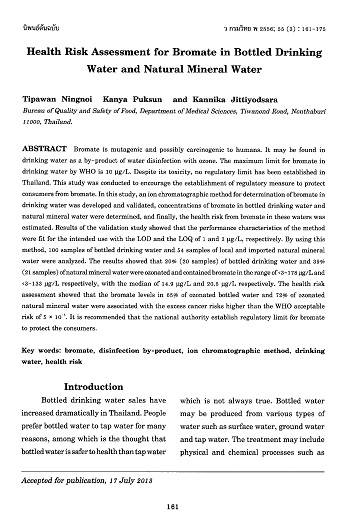การประเมินความเสี่ยงต่อสุขภาพจากโบรเมตในน้ำดื่มบรรจุขวดและน้ำแร่ธรรมชาติ
คำสำคัญ:
bromate, disinfection by-product, ion chromatographic method, drinking water, health riskบทคัดย่อ
โบรเมตเป็นสารก่อกลายพันธุ์และอาจก่อมะเร็งในคน ในน้ำดื่มอาจพบโบรเมตได้โดยเกิดจากกระบวนการฆ่าเชื้อโรคด้วยโอโซน องค์การอนามัยโลกกำหนดให้มีโบรเมตในน้ำดื่มได้ไม่เกิน 10 ไมโครกรัมต่อลิตร แต่ในประเทศไทยยังไม่มีการกำหนดค่ามาตรฐาน งานวิจัยนี้มีวัตถุประสงค์เพื่อกระตุ้นให้มีมาตรการคุ้มครองผู้บริโภคให้ปลอดภัยจากสารโบรเมต โดยได้พัฒนาวิธีวิเคราะห์โบรเมตในน้ำดื่มด้วยเทคนิคไอออนโครมาโตกราฟ สำรวจปริมาณโบรเมตในน้ำดื่มบรรจุขวดและน้ำแร่ธรรมชาติ และประเมินความเสี่ยงจากโบรเมตในน้ำ ผลการทดสอบความถูกต้องของวิธีที่พัฒนาพบว่ามีความเหมาะสมต่อการใช้งานโดยมีขีดจำกัดของการตรวจพบ และการวัดปริมาณที่ 1 ไมโครกรัมต่อลิตร และ 3 ไมโครกรัมต่อลิตร ตามลำดับ ผลของการวิเคราะห์น้ำดื่มบรรจุขวด 100 ตัวอย่าง และน้ำแร่ธรรมชาติที่ผลิตในประเทศและนำเข้าจากต่างประเทศ 54 ตัวอย่าง พบว่าร้อยละ 20 (20 ตัวอย่าง) ของน้ำดื่มบรรจุขวด และร้อยละ 39 (21 ตัวอย่าง) ของน้ำแร่ธรรมชาติ มีการใช้โอโซนและพบโบรเมตอยู่ในช่วง <3 - 178 ไมโครกรัมต่อลิตร และ <3 - 133 ไมโครกรัมต่อลิตร โดยมีค่ามัธยฐานที่ 14.9 และ 20.5 ไมโครกรัมต่อลิตร ตามลำดับ ผลการประเมินความเสี่ยงจากโบรเมตพบว่าร้อยละ 65 และร้อยละ 72 ของน้ำดื่มบรรจุขวดและน้ำแร่ธรรมชาติที่ผ่านโอโซน มีค่าความเสี่ยงต่อการเป็นมะเร็งสูงกว่า 5 x 10-5 ซึ่งเป็นค่าที่องค์การอนามัยโลกยอมรับ ดังนั้นหน่วยงานที่รับผิดชอบจึงควรกำหนดค่ามาตรฐานสำหรับโบรเมต เพื่อคุ้มครองผู้บริโภคให้มีความปลอดภัย
เอกสารอ้างอิง
World Health Organization. Bromate in drinking water. Background document for development of WHO Guidelines for drinking water quality. World Health Organization; 2005. p.2.
Haag WR and Hoigne' J. Ozonation of bromind containing water; kinetics of formation of hypobromous acid and bromate. Environ Sci Technol 1983; 17:261-267.
World Health Organization. Guidelines for drinking water quality. World Health Organization; 2011. p 325.
U.S. Environmental Protection Agency. Method 300.1. Determination of inorganic anions in drinking water by ion chromatography. U.S. Environmental Protection Agency. Cincinnati. Ohio. 1997.
U.S. Environmental Protection Agency. Method 317.0. Rev 2.0. Determination of inorganic oxyhalide disinfection by-product in drinking water using ion chromatography with the addition of a post-column reagent for trace bromate analysis. U.S. Environmental Protection Agency. Cincinnati. Ohio. 2002
U.S. Environmental Protection Agency. Method 321.8 Rev 1.0 Determination of bromate in drinking waters by ion chromatography inductively coupled plasma-mass spectrometry. U.S. Environmental Protection Agency. Cincinnati. Ohio. 1997
Kurakawa Y, Maekawa A, Takahashi M and Hayashi Y. Toxicity and carcinogenicity of potassium bromate- a new renal carcinogen. Environmental Health Perspectives. 1990. Vol.87; p. 309-335.
Nakano K, Okada S, Toyokokuni S and Midorikawa O. Renal changes induced by chronic administration of potassium bromate or ferric nitrilotriacetate in Wistar rats. Jpn Arch Intern Med. 1988. 36: 41-7.
DeAngelo AB, George MH, Kilburn SR, Moore TM and Wolf DC. Carcinogenicity of potassium bromate administered in the drinking water to male B6C3F1 mice and F344/N rats. Toxico Pathol. 1988. 26(5): 587-94.
World Organization. Bromate in drinking water. Background document for development quality. World Health Organization; 2005. p. 8.
Evaluations of the Joint FAO/WHO Expert Committee on Food Additives (JECFA). Potassium bromate. 1995. Available from: http://apps.who.int/ipsc/database/evaluations/chemicals.aspx?chemID=4265 [Cited 15/4/2013]
International Agency for Research on Cancer. Monographs on the evaluation of carcinogenic risks to human. Volume 73. World Health Organization 1999. Available from: URL: http://monograhs.iarc.fr/ENG/Monographs/vol73/volume73.pdf.
U.S. Environmental Protection Agency. Toxicological review of bromate in support of summary information on the Integrated Risk Information System (IRIS). 2001. p. 29. Available from: URL: http://www.epa.gov/iris/toxreviews/1002tr.pdf.
Kurokawa Y, Aoki S, Matsushima Y, et al. Dose-response studies on the carcinogenicity of potassium bromate in F344 rats after long-term oral administration. J Natl Cancer Inst. 1986. 77: 977-982.
World Health Oranization. Disinfection and disinfection by-products. Environment Health Criteria 216. International Programme on Chemical Safety. Available from: URL: http://www.inchem.org/documents/ehc/ehc/ehc216.htm#SubSectionNumber:1.2.9;2000.
DeAngelo AB, Georage MH, Kilburn SR, Moore TM and Wolf DC. Carcinogenicity of potassium bromate administered in the drinking water to male B6C3F1 mice and F344/N rats. Toxico Pathol. 1988. 26(5) : 587-94.
U.S. Environmental Protection Agency. National primary drinking water regulations: Disinfections and disinfection by-products. Fed. Regist. 1998. 63(241), 69389-69476.
Health Canada. Bromate Guidelines. Guidelines for Canadian drinking water quality-supporting documents. Edited January 1999. Available from: URL: http://www.hc-sc.ca/ewh-semt/alt/pdf/pubs/water-eau/bromate/bromate_e.pdf.
World Health Organization. Bromate in drinking water. Background document for development of WHO Guidelines for drinking water quality. World Health Organization; 2005. p. 13.
California Environmental Protection Agency. Public health goal for bromate in drinking water. Pesticide and Environmental Toxicology Branch Office of Environmental Health Hazard Assessment California Environmental Protection Agency. December 2009. p.36. Available from: URL: http://oehha.ca.gov/water/phg/pdf/BromatePHG010110.pdf
European Parliament and Council. Commission Directive 2003/40/EC. Establishing the list, concentration limits and labeling requirements for constituents of natural mineral waters and the conditions for using ozone-enriched air for the treatment of natural mineral waters and spring waters. Official Journal of the European Union. 2003. L.126. p.39. Available from: URL: http://ec.europa.eu/food/labellingnutrition/water/
EURACHEM The Fitness for Purpose of Analytical Methods, First English Edition 1.0-1998
Department of Medical Sciences. A Practical guide for single-laboratory method validation of chemical methods. Nonthaburi: Department of Medical Sciences; 2006.
World Health Organization Food and Agriculture of the United Nations. CODEX Alimentarius Commission Procedural Manual. Twentieth edition. Joint FAO/WHO Food Standards Programme. Rome; 2001. P.70.
Ellison S, Williams A. EURACHEM/CITAC Guide. Quantifying uncertainty in analytical measurement. Third edition.; 2012.
Ketkaew P, Undokloy T and Sutjaritnrtikarn W. Proceedings of 46th Kasetsart University Annual Conference: Science. Quantitative analysis of trace level bromate and chlorate ions in drinking water by ion chromatography. 2008. P.326-333.
Kumar A, Rout S, Singhal RK. Health risk assessment for bromate (BrO3-) traces in ozonated Indian bottled water. J. Environmental Protecton. 2011. 2, 571-580. Doi: 10.4236/jep.2001.25066 Published Online July 2011 Available from; URL: http://www.scirp.org/journal/jep
พระราชบัญญัติอาหาร พ.ศ.2522 ประกาศกระทรวงสาธารณสุข ฉบับที่ 199 (พ.ศ. 2543) ราชกิจจานุเบกษา เล่มที่ 118 ตอนพิเศษ 6 ง. (วันที่ 24 มกราคม พ.ศ.2544)
Codex Standard for natural mineral waters, Codex Standard 108-1981, Revision 2008
European Parliament and Council. Directive 2009/54/EC of the European Parliament and of natural mineral waters. Official Journal of the European Union. 2009. L 164. P. 47. Available from: URL: http://ec.europa.eu/food/labellingnutrition/water/
พระราชบัญญัติอาหาร พ.ศ. 2522 ประกาศกระทรวงสาธารณสุข ฉบับที่ 292 (พ.ศ. 2548) ราชกิจจานุเบกษา เล่มที่ 122 ตอนพิเศษ 140 ง. (วันที่ 7 ธันวาคม พ.ศ. 2548)
U.S. Environmental Protection Agency. Guidelines for carcinogenic risk assessment (SAB review draft). Risk assessment Forum (NCEA-F-0644). Washington D.C.; 1999.

ดาวน์โหลด
เผยแพร่แล้ว
รูปแบบการอ้างอิง
ฉบับ
ประเภทบทความ
สัญญาอนุญาต

อนุญาตภายใต้เงื่อนไข Creative Commons Attribution-NonCommercial-NoDerivatives 4.0 International License.



